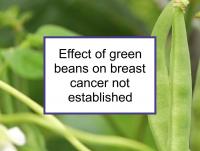Green beans, or string beans, are the unripe pods of common beans (Phaseolus vulgaris). Green beans are a good source of fiber, folate, manganese, beta-carotene, vitamin C and vitamin K. Green beans also incorporate some chlorophyll, and the carotenoids alpha-carotene and lutein, although amounts are modest.
Breast cancer-related effects of eating green beans
As note above, while green beans contain a number of chemopreventive compounds, the amounts are limited compared to many other vegetables. Green bean components beta-carotene and lutein have been found to be associated with lower risk of breast cancer. However, no population studies have been performed that specifically identified an association between green bean consumption and risk of breast cancer.
Carotenoids and breast cancer
Women with substantial intake of carotenoids such as beta-carotene have been reported to have lower risks of breast cancer and its recurrence than those with low intake, although not all studies are in agreement. Lutein consumption and circulating lutein levels have been found to be associated with reduced risk of breast cancer in several epidemiological studies. The (green) chlorophyll content of green beans masks their relatively high carotenoid content.
A Scandinavian study found that dietary (but not supplemental) beta-carotene had a protective effect against lobular breast cancer in postmenopausal women. Another European study reported that high intake of beta-carotene was protective against breast cancer in postmenopausal women using hormone replacement therapy (HRT). The same study also found that dietary beta-carotene was associated with lowered risk of breast cancer in postmenopausal women with relatively high alcohol consumption.
Beta-carotene enhanced the cytotoxicity of doxorubicin in both hormone receptor positive (ER+/PR+) and triple negative (ER-/PR-/HER2-) breast cancer cells in one study. Beta-carotene has also been demonstrated to reduce multidrug resistance in cancer cells. In addition, treatment with beta-carotene has been shown to reduce cardiotoxicity induced by the chemotherapy drug cisplatin in rats.
Additional comments
Green beans lose some of their antioxidant capacity when boiled; other cooking methods are preferable. Frozen beans lose less of their antioxidant activity than canned beans. One study found that up to 24% of the flavonol contents of green beans was leached into the cooking water during commercial processing. Non-organic green beans must be washed very thoroughly to remove pesticide residue as much as possible.
Haricots verts is the French name for green beans. True French green beans are longer and more narrow than common U.S. varieties. The Chinese long bean or yardlong bean (Vigna unguiculata subsp. sesquipedalis) is a type of cowpea.
Asian "green beans" usually refers to mung beans
The "green beans" used in Asian and South Asian cuisines normally are the seeds of the mung bean rather than the green beans described above. Mung bean paste is used similarly to red bean paste (i.e., adzuki bean paste) in Chinese cuisine and can be a good substitute for it.
Note that while we are continually searching for new evidence specifically concerning this food, there is not much interest in it among breast cancer researchers, so few studies are available.
